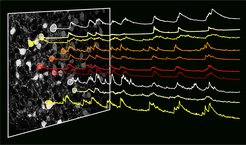Brain region mediates pleasure of eating

Providing the body with food is essential for survival. But even when full, we can still take pleasure in eating. Researchers at the Max Planck Institute of Neurobiology in Martinsried and the Friedrich Miescher Institute in Basel have characterized a type of neuron in the amygdala of the mouse brain that is involved in making eating rewarding. When given the choice, mice choose to activate these amygdala neurons. Artificially activating these neurons increases food intake even when the mice are not hungry. The neurobiologists have identified the neuronal circuitry underlying this behavior, raising the possibility that there could be cells with a similar function in the human brain.
The amygdala in the brain plays a key role in emotional responses, decision-making and association of events with emotions like fear or pleasure. In recent years, it has become apparent that this brain region also plays a role in eating behavior. Researchers at the California Institute of Technology have previously shown that activating a certain type of neurons in the amygdala (known as PKC-delta neurons) causes mice to stop eating. “If the mice eat something which has gone bad, for example, activity of these cells causes them to immediately stop eating,” explains Rüdiger Klein, Director at the Max Planck Institute of Neurobiology. “I found this study on ‘anorexia neurons’ in the amygdala fascinating,” says Klein, “so when three doctoral students with very different methodological backgrounds came to me, I proposed them to work on the amygdala project. Their task was to find out whether there are neurons that are involved in positively regulating food consumption.” With this task in mind, the group focused on a different population of amygdala cells named HTR2a neurons.”
Specializing in behavior, electrophysiology and anatomy, the three doctoral students were able to provide insight into HTR2a cell function from a range of angles. “It was a very collaborative project,” recalls Amelia Douglass, one of the three lead authors of the study, which was published in Nature Neuroscience. “We frequently sat down together, went through the results and then built on them, applying new cutting-edge methods in the process.” Using this approach, the young researchers gradually discovered the role of the previously unstudied HTR2a amygdala cells and identified the neural circuitry involved. “Basically we showed that HTR2a cells have a positive effect on food consumption in mice, and that the mice like it when these cells are active,” says Douglass.
